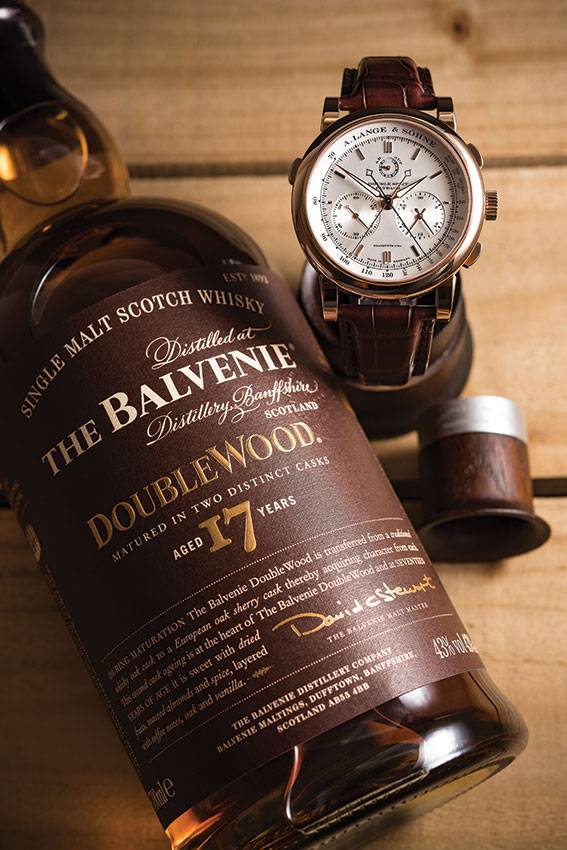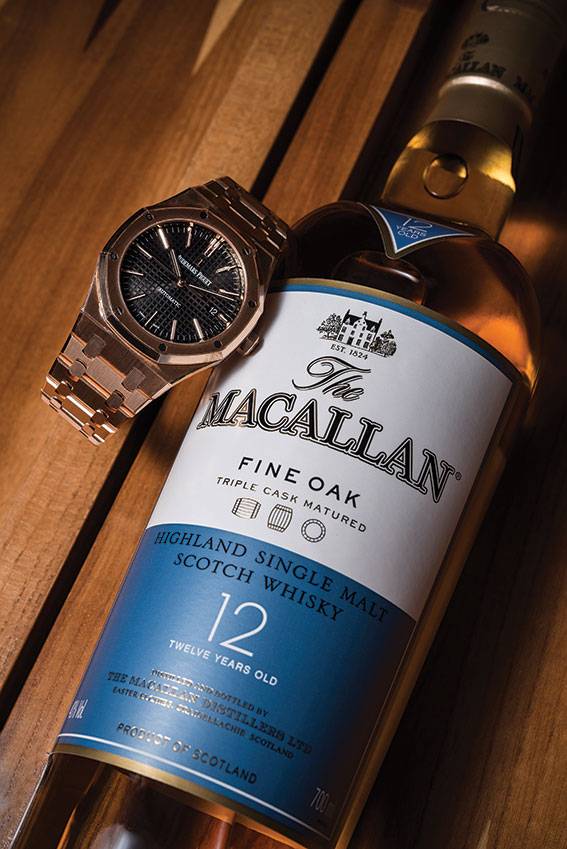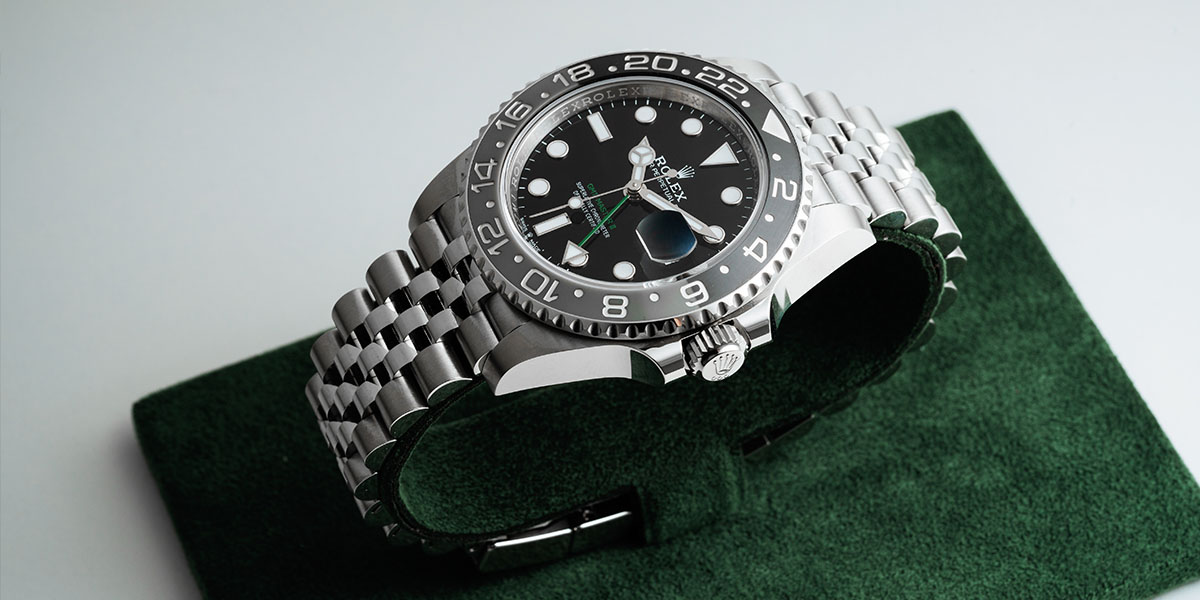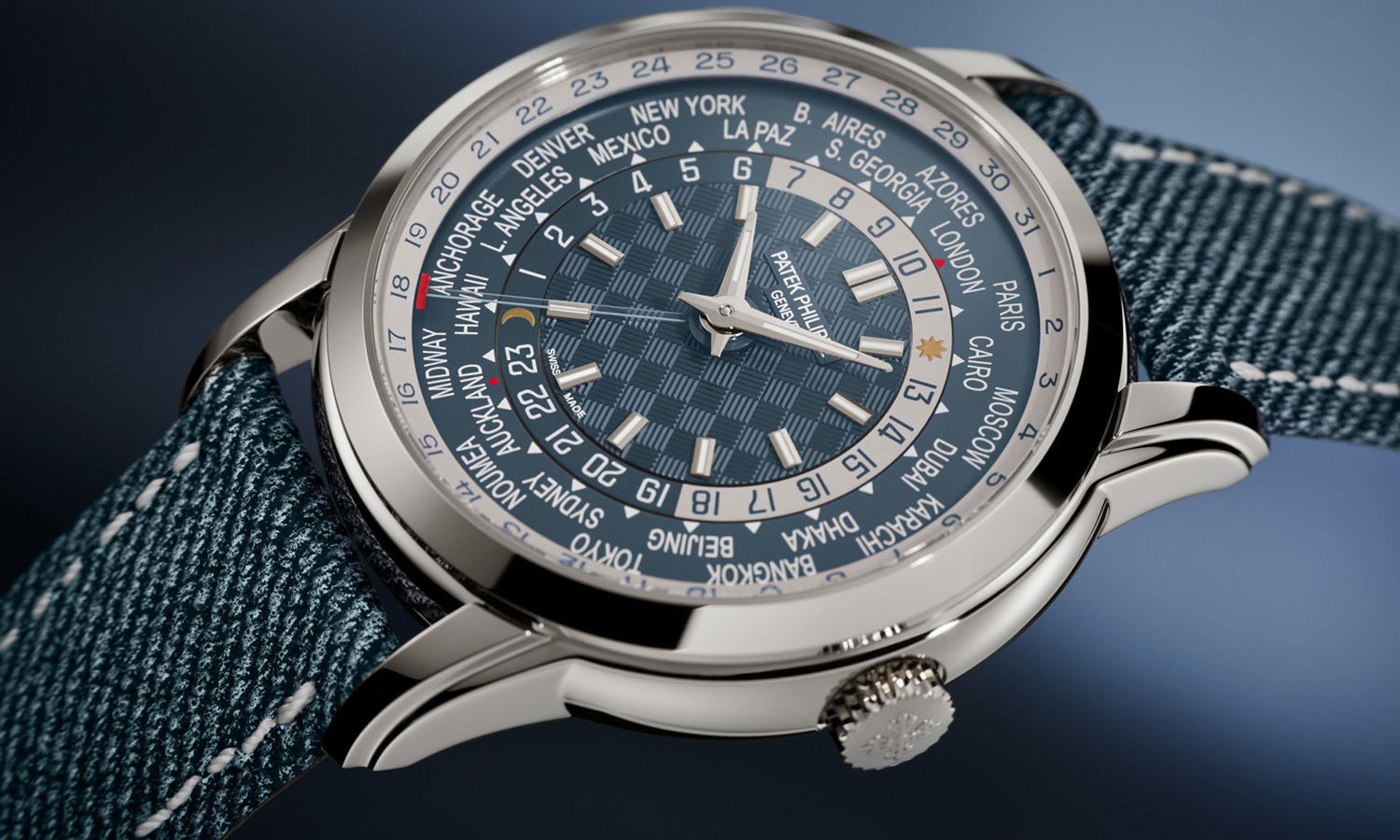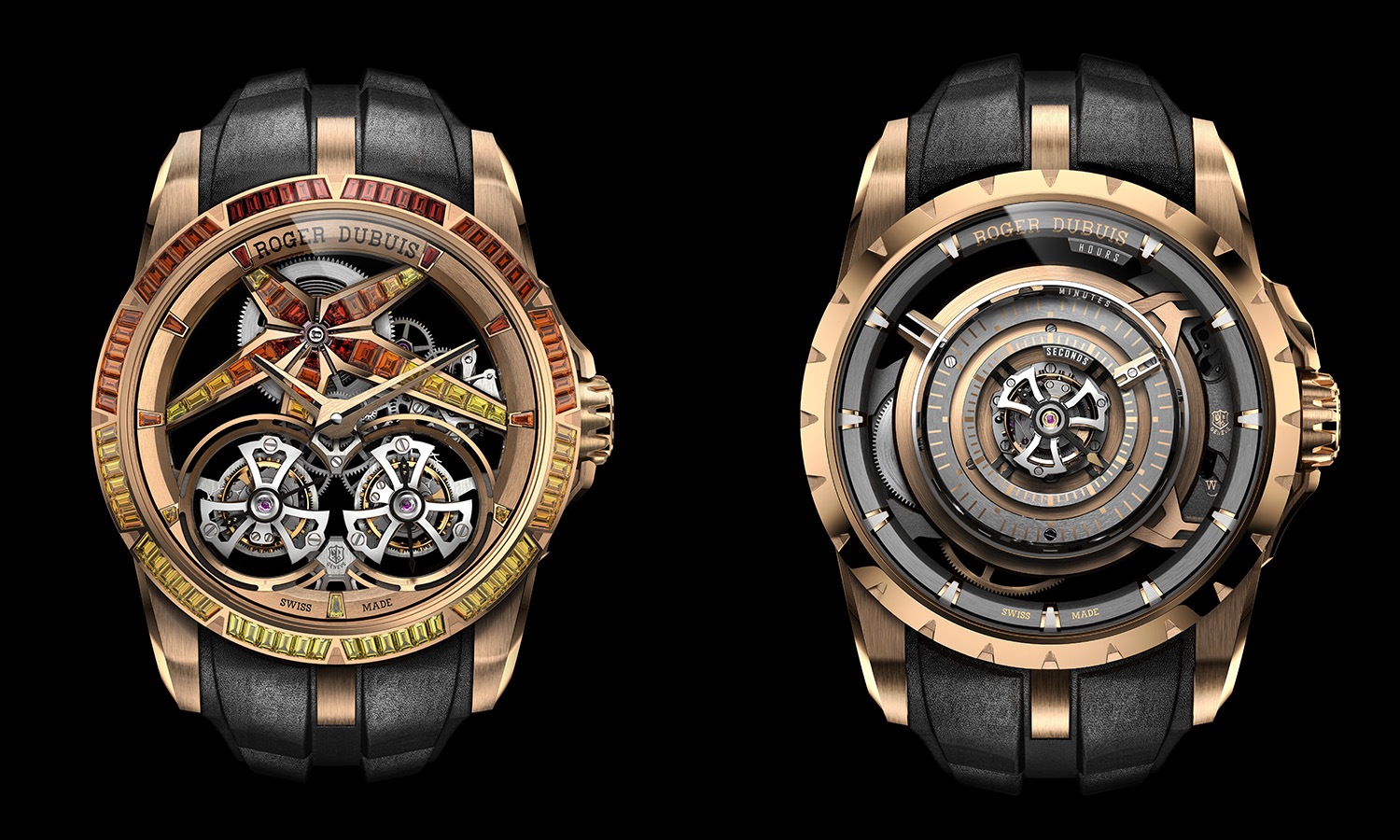
The Best Watch And Whisky Pairings
Balvenie + A. Lange & Söhne
DoubleWood:
Owned by William Grant & Sons and located in Dufftown, The Balvenie is one of the most revered Speyside Single Malt Scotch Whisky distilleries in Scotland. Founded in 1892, The Balvenie is one of the few large Scotch Malt distilleries that still grow its own barley and have kept faith with a traditional malting floor. Master distiller David Stewart has created some of the most distinctive and beautiful Balvenie expressions over the past 53 years, but one of his favourite creations is the DoubleWood maturation. This technique is at the heart of The Balvenie DoubleWood—it sees the whisky matured first in American oak barrels, which impart soft, sweet vanilla notes, before being transferred to European oak sherry casks, where the second cask ageing adds rich, spicy flavours and a depth and fullness of flavour.
Tasting Notes:
On the nose: You’ll experience sweet notes of sherry, followed by a warm waft of toffee, marzipan and vanilla. Notes of raisins, spices and a hint of coffee and sulphur closely follow. After a couple of swirls notes of butterscotch, orange peel, fresh green herbs, aniseed and oak start to emerge.
On the palate: Those sweet notes of sherry are ever present, followed by hints of toasted almond and vanilla. Spicy notes will start to filter through, followed by cinnamon, butterscotch, cocoa, a lovely meaty taste and a note akin to rum-and-raisin ice cream.
The finish: Long, sweet and spicy with lingering zest and oak.
The Verdict:
The DoubleWood maturation process is one that Balvenie has been producing for years, and it is this technique that gives the DoubleWood expression so much character. The 17-year-old DoubleWood is a more mature and mellow version of its younger sibling. It is so well balanced, and keeps offering more notes just as often as you keep nosing and sipping it. No need to stir any water into the mix, though if you must, only add a very small amount. I found that letting it sit in the glass for a short amount of time between nosing and tasting yields the best results.
Info:
ABV 43% in a 70cl bottle
Double Split Flyback
The age-old saying that goes, “Once is good, but twice is better” couldn’t be truer with the A. Lange & Söhne Double Split Flyback Chronograph. First introduced in 2004, this 2010 updated Lange Double Split is absolutely peerless, outfitted with not one, but two rattrapante hands—one for the seconds, and another for the minutes to be stopped. What’s more, both chronograph and rattrapante hands are flyback.
The intricate complication of a rattrapante sweep- seconds hand in a chronograph has always been a horological accomplishment for short-time measurements. From the very beginning it was admired as a milestone in precision engineering, but it always had its limits. Unfortunately the possibility of taking a lap- time reading with the rattrapante sweep-seconds hand during an ongoing measurement was restricted to the 60-second scale, meaning it was only able to record two laps, each less than one minute long—until now.
The Double Split Flyback’s 43.2mm case is made entirely of 18-karat pink gold, with a silver dial that features two subsidiary dials. At 8 o’clock are the customary running seconds while at 4 o’clock are the chronograph minutes and chronograph split minutes, and at the very centre are the rattrapante (split-seconds) hands. At 12 o’clock is the power-reserve indicator, and on the inclined dial flange is the 400-base tachymeter scale. The robust case is fixed to the wrist by a brown leather alligator strap with a matching metal pin-buckle.
At the heart of the timepiece beats a mechanical self- winding movement developed and produced by A. Lange & Söhne—Calibre L001.1—graced with the kind of meticulous finishes that are the unmistakable signatures of Lange. The Lange Double Split Flyback Chronograph is a thing of pure beauty and, with its double rattrapante complication, a mechanical marvel.
The Macallan Fine Oak + Audemars Piguet Royal Oak
Fine Oak:
Located in Moray, Craigellachie, the Speyside distillery that is The Macallan is the third largest selling single malt scotch in the world. Originally, Macallan’s Scotch whisky was, primarily, matured in oak seasoned with sherry brought to the distillery from Jerez, Spain. However, at the beginning of 2004, Macallan introduced a new product: the Fine Oak Series (triple-cask matured), with whisky matured and mellowed in seasoned American oak casks, as well as sherry casks from Spain. The Fine Oak Series was quite a departure for The Macallan distillery and at the time brought about rave reviews from some quarters, even being deemed by one whisky expert “Best New Scotch Brand” when it was launched.
Tasting Notes:
On the nose: You’ll experience an initial waft of old musty oak and honey. After a couple of swirls, notes of apples, pears and citrus zest start to emerge with a hint of dried mango and sherry. There are some lovely fragrant notes of vanilla and cinnamon, alongside fresh floral notes that seem to fade in and out.
On the palate: Those sweet sherry notes seem to appear first, followed by notes of dried mixed fruits. There is a lovely hint of chocolate, followed by cinnamon, nutmeg, cloves and vanilla. Towards the end a very interesting mocha note emerges, alongside the lightest touch of oak.
The finish: Medium,sweet and spicy,with lingering oak.
The Verdict
Macallan as a brand is so well revered around the world and on evidence of this 12-year-old Fine Oak, it’s not hard to see why. This is a Scotch that on the nose is rather rich and complex, but on the palate is much mellower than one would’ve thought: a delightfully-balanced dram in my opinion, but not overly oaky. It’s probably not a Scotch that I would add any water to, but if you feel the need, only add in small quantities until it’s just right for you.
Info:
ABV 40% in a 70cl bottle
Royal Oak
Like The Macallan Fine Oak series, when introduced in 1972, the Royal Oak was something new—not only to Audemars Piguet, but also to the entire watch industry, for it was the first high-end sports wristwatch made in stainless steel. Audemars Piguet was known at this time for making sophisticated high- end wristwatches, but the Royal Oak was a daring new design that made the watch industry stand up and take note. Designed by legendary watch designer Gérald Genta in 1972, the Royal Oak featured a design that appeared complicated yet very minimalistic.
Based on a ship’s porthole, the distinctive monobloc, octagonal bezel—secured by eight hexagonal screws—meant the Royal Oak could be very thin, and with an integrated bracelet, the sports-watch look that AP had desired was achieved. However, one of the most notable designs of the Royal Oak was its “Grande Tapisserie” dial, which featured the famed Clous de Paris motif.
Introduced in 2012, this 18-karat, pink-gold Royal Oak embodies the same spirit of the original 5402 that was introduced in 1972; however, its 41mm case meets the needs of the modern man. The piece features a black “Grande Tapisserie” with pink-gold applied hour-markers. At the heart of the Royal Oak 15400 beats the self-winding calibre 3120, which features one of the most beautifully engraved 22-karat gold oscillation weights. The Royal Oak oozes restraint and sophistication on a level that is nay ostentatious, but rather more established.
Ladyburn + Vacheron Constantin
More Than Meets The Eye:
This Lowland distillery has one of the most unique histories. The Ladyburn malt whisky distillery was created in 1966. However in 1975, the distillery was closed and demolished a year later, making it one of the shortest-lived distilleries in Scotch-whisky history. The Ladyburn was one of the most technological distilleries during its brief stint, and like all distilleries, it has its own characteristics. The 40-year-old bottling exclusive to the Whisky Shop exudes some of the most exquisite notes I have ever experienced within a single bottle of Scotch.
Tasting Notes:
On the nose: You’ll get a sweet and warming waft of marzipan, coupled with some bitter liquorice. These initial notes are then followed by the brand’s signature oily characteristics, along with some creamy notes, linseed oil, aloe vera and a hint of zest. Adding a touch of water reveals notes of Madeira cake, candyfloss and floral hints.
On the palate: Those sweet notes of marzipan on the nose are ever present. Under that creamy and oily texture are notes of vanilla and aniseed, alongside some peppery spices. The palate is nicely finished with notes of herbs, sage, tamarind, and the slightest hint of smoke. The finish: Long, peppery and herbal, with lingering oak.
The Verdict:
At first the Ladyburn seems rather simple, but as you delve deeper, more and more notes start to emerge. It truly is a dram that has more than meets the eye. Due to the rather low ABV percentage, you’d be forgiven for thinking you don’t need to add any, but to cut through those oils you’ll need to add just a few drops of water to allow the Scotch to breathe and unlock the plethora of flavours available.
Info:
ABV 48.6% in a 70cl bottle
Hidden Qualities:
Vacheron Constantin’s Traditionnelle Day-Date and Power Reserve has more to it than meets the eye, with pure aesthetics and a dial with understated appeal. The timepiece that now joins the prestigious Collection Excellence Platine entirely keeps with the aesthetic codes of all the models that have found their place in this collection since 2006.
The Traditionnelle Day-Date and Power Reserve features a classically-sized 39.5 mm-diameter case and a crown crafted from 950 platinum. The uncluttered dial layout made of 950 platinum features a finely-grained, sandblasted finish, discreetly bearing the inscription “Pt 950” between 4 and 5 o’clock. The face provides a central display of the hours, minutes and seconds, as well as pointer- type indications of the power reserve, date and day of the week.
The strap in dark blue Mississippiensis alligator leather is hand-sewn with silk and 950 platinum thread. This combination is made possible by the remarkable malleability of this precious metal, of which a single gram can be drawn out to form an almost two kilometre-long thread. The folding clasp is also made of 950 platinum.
At its heart beats a mechanical self-winding movement developed and produced by Vacheron Constantin—Calibre 2474—graced with the kind of meticulous finishes that are the unmistakable signature of fine watchmaking. The Traditionnelle Day-Date and Power Reserve visually looks simplistic, but features techniques that are only achievable by a true haute horlogerie brand, revealed only upon deeper exploration. Then and only then are the watch’s hidden qualities unveiled.
 SIGN UP
SIGN UP

